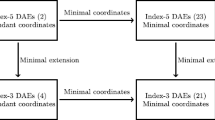Abstract
Most researches focused on the analytical stabilized algorithm for the modular simulation of single domain, e.g., pure mechanical systems. Only little work has been performed on the problem of multi-domain simulation stability influenced by algebraic loops. In this paper, the algebraic loop problem is studied by a composite simulation method to reveal the internal relationship between simulation stability and system topologies and simulation unit models. A stability criterion of multi-domain composite simulation is established, and two algebraic loop compensation algorithms are proposed using numerical iteration and approximate function in multi-domain simulation. The numerical stabilized algorithm is the Newton method for the solution of the set of nonlinear equations, and it is used here in simulation of the system composed of mechanical system and hydraulic system. The approximate stabilized algorithm is the construction of response surface for inputs and outputs of unknown unit model, and it is utilized here in simulation of the system composed of forging system, mechanical and hydraulic system. The effectiveness of the algorithms is verified by a case study of multi-domain simulation for forging system composed of thermoplastic deformation of workpieces, mechanical system and hydraulic system of a manipulator. The system dynamics simulation results show that curves of motion and force are continuous and convergent. This paper presents two algorithms, which are applied to virtual reality simulation of forging process in a simulation platform for a manipulator, and play a key role in simulation efficiency and stability.
Similar content being viewed by others
References
KÜBLER R, SCHIEHLEN W. Modular simulation in multibody system dynamics[J]. Multibody System Dynamics, 2000, 4(2–3): 107–127.
WANG Hao, LIN Zhongqin, LAI Xinmin. Composite modeling method in dynamics of planar mechanical system[J]. Science in China Series E: Technological Sciences, 2008, 51(5): 576–590.
LIANG Silü, ZHANG Heming, WANG Hongwei. Combinative algorithms for the multidisciplinary collaborative simulation of complex mechatronic products based on major step and convergent integration step[J]. Chinese Journal of Mechanical Engineering, 2011, 24(3): 355–363.
CHEN Genliang, WANG Hao, ZHAO Kai, et al. Modular calculation of the Jacobian matrix and its application to the performance analyses of a forging robot[J]. Advanced Robotics, 2009, 23(10): 1 261–1 279.
CELLIER F E, KOFMAN E. Continuous system simulation[M]. Berlin: Springer, 2006.
KÜBLER R, SCHIEHLEN W. Two methods of simulator coupling[J]. Mathematical and Computer Modelling of Dynamical Systems, 2000, 6(2): 93–133.
KÜBLER R, SCHIEHLEN W, SCHOLZ C. Simulator coupling for multibody systems[J]. Proceedings in Applied Mathematics and Mechanics, 2002, 1(1): 33–36.
WANG Hao, EBERHARD P, LIN Zhongqin. Modeling and simulation of closed loop multibody systems with bodies-joints composite modules[J]. Multibody System Dynamics, 2010, 24(4): 389–411.
WANG Hao, CHEN Genliang, LIN Zhongqin. Forward dynamics analysis of the 6-PUS mechanism based on platform-Legs composite simulation[J]. Chinese Journal of Mechanical Engineering, 2009, 22(4): 496–504.
KINCAID D, CHENEY W. Numerical analysis: mathematics of scientific computing[M]. 3rd ed. Hartford: Wadsworth Group, 2002.
BATHE K J, WILSON E L. Numerical methods in finite elements analysis[M]. New York: Prentice-Hall, 1976.
YAN Changya, GAO Feng. Dynamic stability analysis of a novel forging manipulator[C]//1st International Conference on Intelligent Robotics and Applications, Wuhan, China, Oct. 14–19, 2008: 449–458.
ZHAO Kai, WANG Hao, CHEN Guanlong, et al. Compliance process analysis of forging manipulator[J]. Journal of Mechanical Engineering, 2010, 46(4): 27–34. (in Chinese)
LIU Wei, JIA Xinghua, JIA Zhenyuan, et al. Fast dimensional measurement method and experiment of the forgings under high temperature[J]. Journal of Materials Processing Technology, 2011, 211(2): 237–244.
WANG Bangguo, LIU Wei, JIA Zhenyuan, et al. Dimensional measurement method of hot large forgings with stereo vision structured light system[J]. Proceedings of the Institution of Mechanical Engineers, Part B, Journal of Engineering Manufacture, 2011, 225(6): 901–908.
Author information
Authors and Affiliations
Corresponding author
Additional information
This project is supported by National Natural Science Foundation of China (Grant Nos. 51075259, 51121063, 51305256), and National Basic Research Program of China (973 Program, Grant No. 2006CB705400)
HUANG Shunzhou, born in 1984, is currently a PhD candidate at Institute of Automobile Engineering, Shanghai Jiao Tong University, China. He received his bachelor degree from Shanghai Jiao Tong University, China, in 2007. His main research interests include numerical simulation, virtual reality, and manufactured surface inspection.
ZHAO Yong, born in 1979, is currently a lecturer at Institute of Automobile Engineering, Shanghai Jiao Tong University, China. He received his PhD degree from Shanghai Jiao Tong University, China, in 2013. His main research interests include robotics and numerical simulation.
WANG Hao, born in 1973, is currently a professor and a PhD candidate supervisor at Institute of Automobile Engineering, Shanghai Jiao Tong University, China. He received his PhD degree from Tianjin University, China, in 2002. His main research interests include robotics and multibody system dynamics.
LIN Zhongqin, born in 1957, is currently a professor and a PhD candidate supervisor at Institute of Automobile Engineering, Shanghai Jiao Tong University, China. His main research interests include automobile engineering and forming process analysis.
Rights and permissions
About this article
Cite this article
Huang, S., Zhao, Y., Wang, H. et al. Stabilized multi-domain simulation algorithms and their application in simulation platform for forging manipulator. Chin. J. Mech. Eng. 27, 92–102 (2014). https://doi.org/10.3901/CJME.2014.01.092
Received:
Revised:
Accepted:
Published:
Issue Date:
DOI: https://doi.org/10.3901/CJME.2014.01.092




